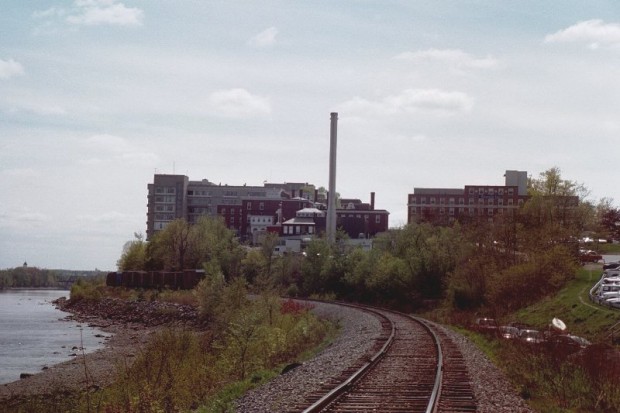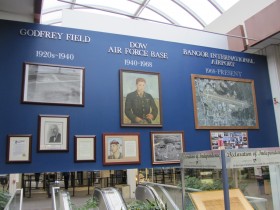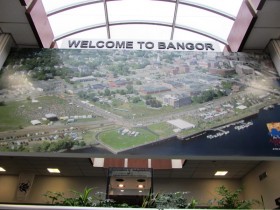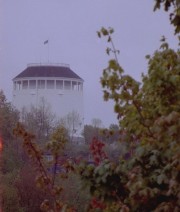
| Year | Population |
|---|---|
| 1970 | 33,168 |
| 1980 | 31,643 |
| 1990 | 33,181 |
| 2000 | 31,473 |
| 2010 | 33,039 |
| Geographic Data | |
|---|---|
| N. Latitude | 45:41:10 |
| W. Longitude | 67:58:35 |
| Maine House | Districts 124,125, 126,127 |
| Maine Senate | District 9 |
| Congress | District 2 |
| Area sq. mi. | (total) 34.7 |
| Area sq. mi. | (land) 34.5 |
| Population/s.mi | (land) 913.7 |
County: Penobscot
Total=land+water; Land=land only |
|
Statehood began a period of explosive population growth, slowing only forty years later:
| 1820 | 1,221 |
| 1830 | 2,867 |
| 1840 | 8,627 |
| 1850 | 14,432 |
| 1860 | 16,407 |
Civil War: Thomas Belcher; Francis S. Hesseltine; Thomas Taylor; Sidney W. Thaxter; Henry W. Wheeler.
Indian Wars: Henry J. Hyde
Interim 1976: Charles Gidding
Bangor Downtown near the Market Square Historic District (2001)
[BAN-gor or BANG-gor] is the major city in, and county seat of, Penobscot County, incorporated as a town on February 24, 1834 from the former Kunduskee (or Kenduskeag) Plantation. On March 26, 1853 the “Queen City” was incorporated as a city just at the beginning of its legendary history as a booming community when logging was king.
The area was first settled by Jacob Buswell and his family in 1769. Others came and went, but even by the beginning of the 19th century Kenduskeag Plantation was a struggling frontier outpost. One estimate has the population at 150 in 1790.
According to Henry Gannett,* Bangor was named by the Rev. Seth Noble, its representative in the legislature, from an old psalm tune.
During the War of 1812, the British forged up the Penobscot River, shelled the community, and ignited a disastrous fire virtually destroying it.
Life was breathed into the area when Maine separated from Massachusetts in 1820. At the time, the vast Maine timberlands were put on the block for private speculation. The wealth of the woods drew investors and fortune hunters.
By the 1830s, Bangor, now a city, was building 500 structures annually. It boasted luxury residences, a grand hotel, a lovely downtown and hoped to surpass Boston in size and importance.
In 1834, the 264-acre Mount Hope Cemetery was established. Now listed on the National Register of Historic Places, it is the second oldest garden cemetery in America, designed to serve as a haven for the living as well as a final resting-place for the deceased.
However, the financial panic of 1837 brought much of the City’s creativity and optimism to a halt. Lumbering finally revived the economy and dominated it in the mid- to late 19th century. Foundries were built to provide stoves for the lumber camps, and the machinery to run huge sawmills; the shoe industry made boots; the tool and dye industry supplied the tools needed in the woods; the ships were built to haul lumber to distant ports.
Until the 1870s, Bangor was the lumber capital of the world with a billion board feet of lumber shipped from its docks. By the 1880’s, the lumber industry had declined significantly, as did the city’s economy. In the 19th century “Maine’s First Mapmaker,” Moses Greenleaf, operated one of his several general stores here, near where the Kenduskeag Stream enters the Penobscot River.
Other smaller industries soon emerged to fill the economic gap left by lumber – shoes, paper, fishing rods, tourism. Cheap hydroelectric power encouraged quantity and diversity. In the late 19th century labor unions emerged in response to the efforts of the Knights of Labor to enact labor reform laws. The following 1903 list of Bangor labor unions provides an insight into the local economy of the time.
Industrial: Sheet Metal Workers; Iron Moulders; Machinists.
Railroads: Railway Conductors; Locomotive Engineers; Locomotive Firemen; Railroad Trainmen; Railroad Telegraphers.
Shipping: Atlantic Coast Seamen; Longshoremen.
Services: Bangor Typographical; Barbers; Cigarmakers; Journeymen Tailors; Painters, Decorators and Paperhangers.
Construction: Bricklayers, Plasterers and Masons; Carpenters and Joiners; Laborers; Electrical Workers; Plumbers, Gasfitters and Steamfitters; Slate, Gravel and Metal Roofers; Stovemounters; Woodworkers.
Transportation: Teamsters.
Manufacturing: Shoemakers.
This industrial adaptation would come to a tragic halt on April 30, 1911, the day of the Great Fire. Fifty-five commercial and residential acres burned in one of Maine’s worst fires.
The economic disaster of the Great Fire was real, but the city rebuilt quickly with the best materials available, in the most avant-garde styles, using architects from Boston and New York as well as Bangor. The Great Fire District is an architectural monument to the dynamic spirit and will to survive.
In the 20th century, with the coming of the automobile, Bangor emerged as the financial, retail and cultural center for northern and eastern Maine. In 1928, John Bapst High School, named for a 19th-century Swiss Jesuit priest and missionary, opened as a parochial high school for boys and girls to accommodate a growing Catholic community. The river, rail service, and the emerging medical center contributed to its continued growth.
The City’s creation of Bangor International Airport capitalizing its position along the great circle route to Europe to key locations in the United States, turned the potential liability into an economic asset. The airport property, BIA, also hosts business and civic institutions. Creating strategic historic districts, historic properties have saved historic treasures. Bangor’s older residential neighborhoods have marked a change of attitude from the “new is always better” approach of Urban Renewal in the late downtown restoration and revitalization, and interest in 1960s. During that period, the classic Union Station was razed, along with many other historic structures. But the landmark Standpipe has escaped demolition and still towers over the city
However the phenomenal expansion of a former dairy farm’s fields into the huge and growing Bangor Mall complex has moved and changed the location and architecture of most of the commercial exchange.
The downtown property has avoided scarring demolition, retaining decades of historic commercial structures and some civic institutions.
The Queen City’s famous citizens include author Stephen King; Abraham Lincoln’s first Vice-President, Hannibal Hamlin, U.S. Senator, William S. Cohen, and Secretary of Defense,
GOVERNORS
1821-1821 William D. Williamson
1838-39;41-42 Edward Kent
1857-1857 Hannibal Hamlin
1881-1883 Harris M. Plaisted
1889-1893 Edwin C. Burleigh
1921-1921 Frederick H. Parkhurst
1959-1959 Robert N. Haskell
1987-1995 John R. McKernan, Jr.
Strict historical ordinances, downtown restoration and revitalization, and interest in Bangor’s older residential neighborhoods has marked a change of attitude from the “new is always better” approach of Urban Renewal in the late 1960s. During that period, the classic Union Station was razed, along with many other historic structures. The landmark “Standpipe” at left, however, still towers over the city.
The hospital above has become an arm of Northen Lights medical
On June 15, 1955, the city briefly became a ghost town as it participated in a national civil defense exercise in which about fifty cities across the country were evacuated. Hospitals and public safety organizations assisted “victims” of a nuclear attack. Dow Air Force Base provided an economic and civic boost during the Cold War until its decommissioning in 1968, resulting in a major loss of population.
The City’s creation of Bangor International Airport, (SEE AIRPORTS) capitalizing on its strategic position along the great circle route from Europe to key locations in the United States, turned the potential liability into an economic asset. The BIA property also hosts business and civic institutions.
Bangor Standpipe (2001) Strict historical ordinances, downtown restoration and revitalization, and interest in Bangor’s older residential neighborhoods has marked a change of attitude from the “new is always better” approach of Urban Renewal in the late 1960s. During that period, the classic Union Station was razed, along with many other historic structures. The landmark “Standpipe” at left, however, still towers over the city.
The downtown area remained a huge parking lot for nearly two decades with development hindered by the phenomenal expansion of a former dairy farm’s fields into the huge and growing Bangor Mall complex.
Recent years have seen real renewal in the city’s downtown with a children’s museum, a local theater company, and recreational development of the Penobscot riverfront.
Queen City’s famous citizens include author Stephen King; Hannibal Hamlin, Abraham Lincoln’s first Vice-President; William S. Cohen, a U.S. Senator and Secretary of Defense; and a series of governors:
1821-1821 William D. Williamson
1838-39;41-42 Edward Kent
1857-1857 Hannibal Hamlin
1881-1883 Harris M. Plaisted
1889-1893 Edwin C. Burleigh
1921-1921 Frederick H. Parkhurst
1959-1959 Robert N. Haskell
1987-1995 John R. McKernan, Jr.
U.S. Representatives to Congress from Bangor include Elisha H. Allen, John R. McKernan, Jr., Gorham Parks, Donald F. Snow, Charles Stetson and John G. Utterback (who was also an alderman and mayor). 19th century U.S. Senator Wyman B. Moor was a resident here when appointed to the U.S. Senate.
Three major league baseball players had Bangor as their birthplace. Matt Kinney, born in 1976, had a career spanning 2000 through 2005 with the Minnesota Twins, Milwaukee Brewers, Kansas City Royals, and San Francisco Giants. In the 19th century Bobby Messenger, born in 1884, played for the Chicago White Sox from 1909 through 1911; and the St. Louis Browns in 1914. Pat O’Connell, born in 1861, played one year, 1886, for the Baltimore Orioles.
The Bangor Auditorium, with its trademark Paul Bunyan presence, and nearby Bass Park raceway, attracted major events to the city from 1955 to 2013, when it was demolished and replaced with the Cross Insurance Center.. Bangor is home to several institutions of higher learning: Bangor Theological Seminary, Beal College, Eastern Maine Community College, Husson University, and a branch of the University of Maine system.
The National Register of Historic Places has placed over thirty-five buildings or sites in Bangor on its extensive list of historic places.
Form of Government: Council-Mayor-Manager.
Additional resources
*See Glossary, source number 7.
Arndt, John Christopher. “The Solid Men of Bangor”: Economic, Business and Political Growth on Maine’s Urban Frontier, 1769-1845. Thesis (Ph.D.)– Florida State University, 1987.
City of Bangor, Me. The Charter and Ordinances of the City of Bangor: Together with Acts of the Legislature Relating to the City. City of Bangor, Me. 1915.
Bangor Board of Trade (Me.) The City of Bangor: A Condensed Historical and Descriptive Review Together with a Brief Statement of Facts Relating To Her Commercial and Manufacturing Advantages, Industries and Resources: Also Her Leading Manufactures and Exports For The Year 1882. Bangor , Me. The Board. 1883. (Mining and Industrial Journal)
Callinan, M. J. The Bangor Fire, April 30, 1911: A True Story of the Fire. Augusta , Me. Kennebec Journal Press, 19–?
Chadbourne, Ava Harriet. Maine Place Names and The Peopling of its Towns.
Godfrey, John Edwards. History of Penobscot County: The Annals of Bangor, 1769-1882. Salem, Mass. Higginson Book Company. 1990.
Hannemann, Paul. Little Known Historical Facts about Bangor and the North Country. Bangor , Me. Bangor Historical Society. 1952.
Hawkins, Viola M. History of the Bangor Ward (1832-1970). Bountiful , Utah . Family History Publishers. c1994.
Hayes, Kenneth P. Public Opinion and Policy Evaluation in Bangor, Maine. 1975. Orono, Me. Social Science Research Institute. 1976.
Paine, Albert Ware. The Territorial History of Bangor Maine . Portland, Me. 1887. “Reprinted from Volume IX, Collections of Maine Historical Society.”
Scontras, Charles A. Two Decades of Organized Labor and Labor Politics in Maine 1880-1900. Orono, Me. University of Maine. Bureau of Labor Education. 1969.
Scree, Trudy I. Mount Hope Cemetery: A Twentieth-Century History. Bangor Daily News, June 16, 1955, p.1.
Thompson, Deborah. Architectural Papers 1978-1984. The architectural papers concern primarily the research and writing of the book Bangor, Maine, 1769-1914: An Architectural History. The collection includes manuscripts, proofs, and notes. Special Collections, Fogler Library, University of Maine. Orono.
Thompson, Deborah. Bangor Historic Resources Inventory. Bangor, Me. City of Bangor Community Development Department. 1986.
Thompson, Deborah. Bangor, Maine 1769-1914: An Architectural History. Orono, Maine University of Maine Press. 1988
Last update: June 7, 2021
National Register of Historic Places –Bangor
The old Bangor Auditorium has been replaced with the Cross Center.





























